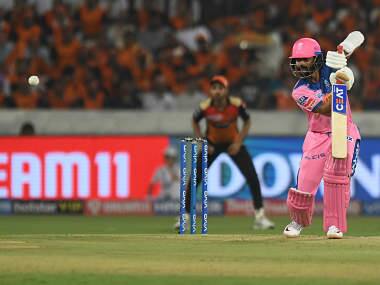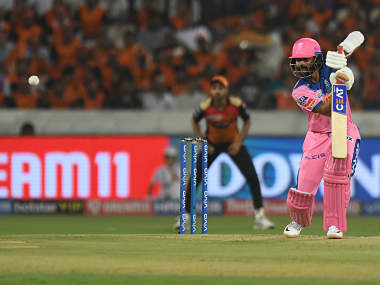We should have been talking about Sanju Samson. In a game where risk-taking is inherent to success, a century in a T20 match is rare. And it is even rarer for a batter to score a hundred and still end up on the losing side, which is what Samson endured despite his second IPL century. [caption id=“attachment_6355831” align=“alignleft” width=“380”]
 Rajasthan Royals captain Ajinkya Rahane plays a shot during their 2019 Indian Premier League match against Sunrisers Hyderabad. AFP[/caption] We should have been talking about the bowlers. In games where the pitch has more than 400 runs in it, and both batting sides run amok, it is often the bowling that is the differentiator. There too, Rajasthan had the better individual performance, with Shreyas Gopal claiming three economical wickets. So how does a side with the highest scorer on the day, the highest wicket taker on the day, who force the opposition to do something they have never done, still lose? Let’s look at both batting innings side by side. Rajasthan Royals (RR) had the better finish, scoring 76 off their last five overs; Sunrisers Hyderabad (SRH) scored 36 off the four they faced. In the middle, both teams performed similarly: RR scored 87 from overs seven to 14, SRH scored 96. But it is the first six overs that tells you the story, and where their paths diverged; SRH scored 69, thanks to David Warner and Jonny Bairstow. RR scored 35. Which brings us to the player we are focussing on, Ajinkya Rahane. Rahane faced 20 of the 36 balls of the powerplay, and scored 20 runs. In the period of the match most fertile for boundary hitting, with just two players guarding the ropes, he hit one boundary. According to CricViz, he attacked just 40 percent of the balls he faced, that is eight. He batted like RR had lost a lot of wickets upfront, but they lost just one (albeit a big one). And so Rahane’s innings reminded me of a headline from an article by journalist Tim Wigmore: The art of the match-losing innings. The example Wigmore started the article with was was, you guessed it, Rahane. Perhaps Rahane simply doesn’t trust his middle order as much. Or perhaps we are being unfair, and the pitch was not as easy to bat on, and this dictated the slow pace of Rahane’s start. Pitches at the Rajiv Gandhi International Stadium have been a bit slow last season. Warner himself expressed surprise that the wicket had as many runs in it. Rahane said, “We thought 190+ on that wicket was really good. Initially when me and Sanju were batting, the wicket was stopping a bit. We were aiming to get 150+.” But both captains wanted to bat first, indicating that Rahane enjoyed the best conditions for batting. Hindsight informs us that RR could have been more aggressive; they scored 198, using only four of their considerable batting resources. That says, that the batsmen took too few risks. Yes, Rahane did increase the pace at the back end, raising his attack percentage to 62, and finishing with a strike rate of almost 143, above his career strike rate of 120.8. But if his risk-appetite in the Powerplay is lower than it can be – and this is not a one-off, it is how he plays – should he be opening the batting at all? This conundrum is similar to the situation the Indian women’s team faced with Mithali Raj. Like Rahane, Mithali’s class is undoubted, as is her pedigree in the longer formats. Like Rahane, her leadership skills are well established. Like Rahane, her natural game involves consolidation followed by acceleration. But for a number of years, India used her as an opener in T20, a tactic that has recently proven to be behind the times. Instead of giving their best player the most overs to bat, teams are giving their fastest scorers the opportunity in the first six overs. I’ve written before that Mithali is more suited for the middle order, while another batter can be used up the order to take advantage of the Powerplay. If early wickets fall, Mithali could stabilise; if things go to plan, she could bat lower, and only if necessary. Could a similar reimagination work for Rahane and RR? Options exist. At the back end of the last season, Rahul Tripathi was returned to the opening slot, in the company of belligerent Jos Buttler, a combination that showed flashes of success. Tripathi has a career SR of 141, and is known to enjoy pace on the ball. He is wasted down the order, and can be promoted with a licence to go after the bowling. Using Rahane in the middle order might also fill the gap in experience that currently exists there. Yes, Rahane provides stability, but in good batting conditions and with a quality batting order, stability is often overrated. A situation like this prompts another hard question, one that is impossible to answer from the outside, but should be put out there: Would a decision like this have been easier if Rahane was not captain? For all the latest news, opinions and analysis from IPL 2019, click here
For the full schedule, date, time and venue of all the matches of IPL 12, click here
The author is a former India cricketer, and now a freelance journalist and broadcaster. She hosts the YouTube Channel,
‘Cricket With Snehal’
, and tweets @
SnehalPradhan
Rajasthan Royals captain Ajinkya Rahane plays a shot during their 2019 Indian Premier League match against Sunrisers Hyderabad. AFP[/caption] We should have been talking about the bowlers. In games where the pitch has more than 400 runs in it, and both batting sides run amok, it is often the bowling that is the differentiator. There too, Rajasthan had the better individual performance, with Shreyas Gopal claiming three economical wickets. So how does a side with the highest scorer on the day, the highest wicket taker on the day, who force the opposition to do something they have never done, still lose? Let’s look at both batting innings side by side. Rajasthan Royals (RR) had the better finish, scoring 76 off their last five overs; Sunrisers Hyderabad (SRH) scored 36 off the four they faced. In the middle, both teams performed similarly: RR scored 87 from overs seven to 14, SRH scored 96. But it is the first six overs that tells you the story, and where their paths diverged; SRH scored 69, thanks to David Warner and Jonny Bairstow. RR scored 35. Which brings us to the player we are focussing on, Ajinkya Rahane. Rahane faced 20 of the 36 balls of the powerplay, and scored 20 runs. In the period of the match most fertile for boundary hitting, with just two players guarding the ropes, he hit one boundary. According to CricViz, he attacked just 40 percent of the balls he faced, that is eight. He batted like RR had lost a lot of wickets upfront, but they lost just one (albeit a big one). And so Rahane’s innings reminded me of a headline from an article by journalist Tim Wigmore: The art of the match-losing innings. The example Wigmore started the article with was was, you guessed it, Rahane. Perhaps Rahane simply doesn’t trust his middle order as much. Or perhaps we are being unfair, and the pitch was not as easy to bat on, and this dictated the slow pace of Rahane’s start. Pitches at the Rajiv Gandhi International Stadium have been a bit slow last season. Warner himself expressed surprise that the wicket had as many runs in it. Rahane said, “We thought 190+ on that wicket was really good. Initially when me and Sanju were batting, the wicket was stopping a bit. We were aiming to get 150+.” But both captains wanted to bat first, indicating that Rahane enjoyed the best conditions for batting. Hindsight informs us that RR could have been more aggressive; they scored 198, using only four of their considerable batting resources. That says, that the batsmen took too few risks. Yes, Rahane did increase the pace at the back end, raising his attack percentage to 62, and finishing with a strike rate of almost 143, above his career strike rate of 120.8. But if his risk-appetite in the Powerplay is lower than it can be – and this is not a one-off, it is how he plays – should he be opening the batting at all? This conundrum is similar to the situation the Indian women’s team faced with Mithali Raj. Like Rahane, Mithali’s class is undoubted, as is her pedigree in the longer formats. Like Rahane, her leadership skills are well established. Like Rahane, her natural game involves consolidation followed by acceleration. But for a number of years, India used her as an opener in T20, a tactic that has recently proven to be behind the times. Instead of giving their best player the most overs to bat, teams are giving their fastest scorers the opportunity in the first six overs. I’ve written before that Mithali is more suited for the middle order, while another batter can be used up the order to take advantage of the Powerplay. If early wickets fall, Mithali could stabilise; if things go to plan, she could bat lower, and only if necessary. Could a similar reimagination work for Rahane and RR? Options exist. At the back end of the last season, Rahul Tripathi was returned to the opening slot, in the company of belligerent Jos Buttler, a combination that showed flashes of success. Tripathi has a career SR of 141, and is known to enjoy pace on the ball. He is wasted down the order, and can be promoted with a licence to go after the bowling. Using Rahane in the middle order might also fill the gap in experience that currently exists there. Yes, Rahane provides stability, but in good batting conditions and with a quality batting order, stability is often overrated. A situation like this prompts another hard question, one that is impossible to answer from the outside, but should be put out there: Would a decision like this have been easier if Rahane was not captain? For all the latest news, opinions and analysis from IPL 2019, click here
For the full schedule, date, time and venue of all the matches of IPL 12, click here
The author is a former India cricketer, and now a freelance journalist and broadcaster. She hosts the YouTube Channel,
‘Cricket With Snehal’
, and tweets @
SnehalPradhan
IPL 2019, SRH vs RR: Should Ajinkya Rahane be opening the batting for Rajasthan Royals going forward?
Snehal Pradhan
• March 30, 2019, 10:25:18 IST
If Ajinkya Rahane’s risk-appetite in the Powerplay is lower than it can be – and this is not a one-off, it is how he plays – should he be opening the batting at all?
Advertisement
)
End of Article